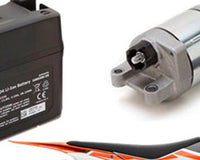Table of Contents
Without batteries, we wouldn't be able to build any wireless electronic devices, and we’d rely solely on wired power sources—even space missions and electric cars wouldn't be possible.
That said, the type of batteries you choose can make a big difference in your devices’ overall performance and lifespan.
Batteries can be grouped into:
- Primary (non-rechargeable)
- Secondary (rechargeable)
We'll break down these two battery types so you can get the most out of your devices.
1 — Primary Batteries
Primary batteries (dry cells) are also known as disposable batteries because you cannot recharge them.
They come in all the standard sizes and voltages, including AA, AAA, C and D, making them an effective power source for any device.
Since they’re non-rechargeable, you should use them until their voltage is too low to function, then dispose of them properly, following local guidelines and regulations since they can leak heavy metals and harmful chemicals into the environment.
The main types of primary batteries include:
- Lithium
- Alkaline
- Carbon zinc
- Silver oxide
Lithium Battery

Lithium batteries are the most recent innovation in primary battery technology. These lightweight, high-energy density, and long-lasting power sources are ideal for various types of devices, ranging from smartphones to electric cars.
Lithium batteries are only available in 9V, AA and AAA sizes, but their mAh ratings outperform any other non-rechargeable battery. For example, one AA lithium battery has a capacity of 2700–3400 mAh and will last a long time even under heavy use.
The table below summarises the advantages and disadvantages of lithium batteries:
| Pros | Cons |
|
|
Alkaline Battery
Alkaline batteries have a manganese dioxide cathode and a zinc anode and use an electrolyte base such as potassium hydroxide.
They have a power density of 100 Wh/Kg and a nominal voltage of 1.5 V, making them ideal for low-to-medium-power electronics such as:
- MP3 players
- Clocks
- Remote controls
- Digital cameras
- CD players
- Electronic toys
- Flashlights
Compared to zinc-type batteries, alkaline batteries have a longer shelf life, higher density, and maintain power in high-drain devices.
However, while they're more affordable than lithium batteries, alkaline batteries only have about half the shelf life and a fraction of the energy density of lithium batteries.
The table below summarises the benefits and drawbacks of alkaline batteries:
| Pros | Cons |
|
|
Carbon Zinc Battery
Carbon zinc batteries are pretty affordable, but they have a low energy density. Often, these batteries can't supply enough power to a high-drain device beyond turning it on. So, they’re better suited for low-drain devices such as toys, remotes and low-power torches.
Carbon zinc batteries are low-cost alternatives to alkaline and lithium batteries and have a capacity that ranges from one-quarter to one-fifth of that of alkaline batteries.
They come in standard sizes and have a shelf life of two to three years, but they're susceptible to hot and cold temperature extremes.
The table below summarises the advantages and disadvantages of carbon zinc batteries:
| Pros | Cons |
|
|
Silver Oxide Button Cell
Silver oxide batteries are button cells made of silver. They have a long operating life and high energy density, supplying nearly twice the energy of an alkaline button cell battery.
These batteries are designed for small electronic devices such as power watches and hearing aids and are not available in AA or AAA sizes.
The table below summarises the pros and cons of silver oxide batteries:
| Pros | Cons |
|
|
2 — Secondary Batteries
Secondary batteries (rechargeable batteries) are more powerful and durable than primary cells. In addition, they can be recharged, making them ideal for powering high-efficiency equipment like laptops, smartphones and electric cars.
Secondary batteries also reduce the negative impact of cells on the environment since they produce less waste than primary batteries.
The main types of rechargeable batteries you can find on today's market include:
- Lithium-ion
- Nickel-cadmium (NiCd)
- Nickel metal hydride (NiMH)
- Lead-acid gel
Lithium-Ion Battery
Lithium-ion, or Li-ion batteries, are used in many devices today and provide good performance, charge faster and last longer than other battery types.
They’re made of ultra-breathable carbon and lithium, making them lightweight.
Li-ion batteries also have a high energy density, allowing them to store a significant amount of power for hours of use. However, they usually require a specific charger, and you can rarely interchange them with other devices.
The table below summarises the benefits and drawbacks of Li-ion batteries:
| Pros | Cons |
|
|
Nickel-Cadmium Battery (NiCd)
Metallic cadmium and nickel oxide hydride are used as electrodes in NiCd batteries. They come in wet, sealed and ventilated cell forms.
The wet cell type has a high self-discharge rate, so it’s not suitable for most devices.
Sealed NiCd batteries are used in a variety of applications, including:
- Emergency and solar lighting
- Flashlights
- Photography equipment
- Portable electronic devices
- Portable power tools
Larger ventilated cells, on the other hand, are used in:
- Emergency and solar lighting
- Uninterruptible power supplies
- Standby power
- Electric vehicles
- Aircraft starting batteries
NiCd batteries have a powerful and consistent voltage output, meaning that if a NiCd battery powers a flashlight, the light will remain constant until the battery dies. However, if an alkaline battery powers the same flashlight, the light will dim as the battery power runs out.
NiCd batteries also charge quickly, but their energy capacity can diminish over time if you don't fully discharge them before recharging.
The table below summarises the advantages and disadvantages of NiCd batteries:
| Pros | Cons |
|
|
Nickel Metal Hydride Battery (NiMH)
NiMH batteries are rechargeable batteries that have a nominal voltage of 1.2 V. Their energy density is almost the same as a lithium-ion battery, while their capacity triples that of a NiCd battery.
NiMH batteries operate at full capacity until nearly all energy has been discharged, making them ideal for flashlights, cameras and other high-power devices.
However, they can only be recharged about 500 times, and overcharging them can diminish their energy capacity.
The table below summarises the pros and cons of NiMH batteries:
| Pros | Cons |
|
|
Lead-Acid Gel Batter
Lead-acid gels are valve-regulated (VRLA) batteries with sulfuric acid and fumed silica electrolytes.
Lead-acid batteries are available in both sealed and unsealed designs.
If you have a sealed battery, you won't have to fill it with water. The battery will require minimal maintenance. On the other hand, unsealed batteries need more care and must be refilled with water over time.
Gel electrolyte batteries are also more resistant to drying out, making them ideal for higher temperature environments.
You can use lead-acid batteries in:
- Backup power
- Car batteries
- Wheelchairs and golf carts
- Energy storage (for off-grid electronic power systems and solar systems)
That said, lead-acid is less durable than lithium and nickel-based batteries when used in deep cycling.
The reason is that a full discharge will cause more strain on lead-acid batteries than lithium or nickel-based batteries. That will eventually make a lead-acid battery lose its energy capacity, reducing its performance over time.
The table below summarises the advantages and disadvantages of lead-acid gel batteries:
| Pros | Cons |
|
|

Get Your Batteries From HBPlus Battery Specialists
We design, manufacture and distribute a wide range of batteries.
At our Carrum Downs warehouse in Victoria, we can refurbish and re-pack batteries on-site, providing quality service at an affordable cost.
Here’s what a verified buyer said:
“I can highly recommend Battery Specialists both for quality batteries and excellent service. I will be buying from them again.”
— Paul D. Bundaberg
Contact us today for all of your battery needs.
Frequently Asked Questions
Which battery lasts the longest?
Lithium-ion batteries last the longest and have the highest capacity.
With a long shelf life, low self-discharge, and low cost, alkaline non-rechargeable batteries come in second.
What does 12 V mean?
12 V indicates that the battery supplies 12 volts under a nominal load. The same principle applies to a 24 V battery bank, which provides 24 volts.
Most car and RV batteries are 12 V.
How do I know if my battery is AGM?
An AGM battery always has a flat top with protruding negative and positive terminals.
On the other hand, liquid acid batteries have a removable top, which AGM batteries don't have because they're properly sealed.










